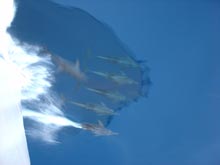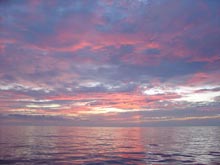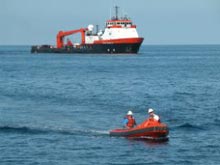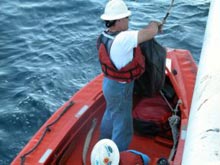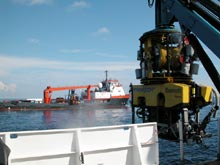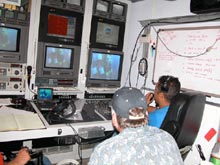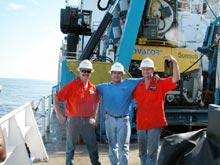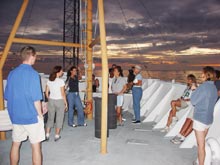
Members of the crew and science party enjoy a fiery sunset on the bow of the Ronald H. Brown. Click image for larger view.
A Lovely Sunset and A Moment to Reflect
September 27, 2003
Sarah Bernhardt
Flower Garden Banks National Marine Sanctuary, NOAA
With the ROV still experiencing electrical issues, and with all samples processed and ROV videos duplicated, many on board took time to enjoy a spectacular sunset from the bow of the ship last night.
Those of us witnessing this fiery display also saw a pod of about 25 spotted dolphin frolicking within the bright orange reflection on the glassy water. After a few minutes of joyful antics, these graceful, energetic creaturess made their way to the bow of the ship, where their high-speed performance of surfing in the wake brought cheers and laughter from the crowd! It was a scene that could not have been choreographed more perfectly on a Hollywood movie set.
The eerie glow of dozens of oil platforms could be seen in the background during this phenomenal display, and a few of the scientists took a moment to reflect on their common mission. Regardless of individual objectives, each is participating in this expedition to learn as much as possible about this poorly understood region that is heavily utilized by the oil and gas industry, to aid in better management and protection of this very special body of water. The ever-present oil platforms are a constant reminder of the importance of this work.
The morning began with the transfer of Innovator ROV parts from a Sonsub ship to the ROV technicians on board the NOAA Ship Ron Brown. The Sonsub crew spent the morning working through the electrical issues that had plagued them on and off for weeks, and replaced several computer boards that apparently blew out during the last dive.
Once the blown-out computer boards were replaced, the Sonsub crew put the ROV through a series of diagnostic tests to ensure that all electrical systems were working properly, and then sent the ROV on a test dive.
Once the "wet test" was successfully completed and it was determined that the ROV was ready to continue with the scientific mission, we steamed to our next dive site at West Flower Garden Bank. With the ROV in working order, the objective is to survey and sample as much as possible, and to keep the ROV on the bottom for as long as possible, since the weather is predicted to take a turn for the worse by tomorrow night. The prediction is for 6- to 10-ft swells, and the ROV cannot be launched in such high seas.
Needless to say, we are all keeping our fingers crossed for good weather since we have already lost some critical ROV bottom time to technical difficulties.
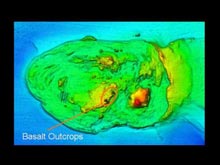
Figure 1. A sea-floor map of Alderdice Bank made during a previous research cruise. The basalt outcrops are circled. Click image for larger view.
Mystery Rocks from Under the Sea
John Bratton
U.S. Geological Survey
Woods Hole, MA
To a geologist, every rock tells a story. Some of those stories are straightforward, even dull, while others are puzzling and fascinating. One such rock was recovered from a dry oil well drilled in Mexico many years ago, but was not appreciated for what it was for more than a decade. It turned out to be glass resolidified from rock melted by a huge asteroid that hit Earth 65 million years ago, leaving a giant crater (now buried) behind. The dinosaurs did not survive this event. Other mysterious rocks have been recovered from the bottom of the Gulf of Mexico. Here are the current versions of two "mystery rock" stories.
Hot Rocks from Cold Water
On an underwater hill known as Alderdice Bank (Fig. 1), 100 mi south of the coast of Louisiana, a ledge of hard alien rock juts out of the sea floor to a height of almost 75 ft (Fig. 2). The rock is 80-million-year-old basalt, which is not so rare. The problem is that basalt is an igneous rock formed from cooled magma, while the rest of the sea floor in the northern Gulf of Mexico consists entirely of sediments such as mud and sand, or sedimentary rocks such as limestone, sandstone, and shale. The nearest igneous rocks exposed at the surface are found in central Texas.
The Alderdice basalt is embedded in a salt dome (see Subterranean Salt Domes) made of salt approximately twice its age. So how did it get there? When it was discovered about 20 years ago, scientists theorized that the basalt was formed thousands of feet down within the Earth’s crust. It seems to have been rafted up to the surface by rising salt, and then exposed at the sea floor as the salt dissolved away. No similar outcrops are known to exist in the Gulf of Mexico, although there may be others that have not yet been discovered. There are reports of exposures like this in Africa near the Red Sea. The rock is only lightly encrusted with sponges, algae, and coral, indicating that it only recently emerged from the salt. The exact timing is unknown. Lots of fish like to gather around the basalt pinnacles. Why? We don’t know that either.
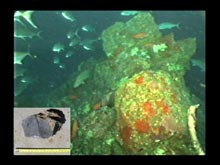
Figure 2. A photograph of the mysterious basalt outcrop on Alderdice Bank in the Gulf of Mexico, surrounded by fish and encrusted with algae and sponges. An ROV took the picture in about 220 ft of water. The inset photo shows a sample of the basalt back on deck. Its microscopic crystals indicate that it cooled quickly below the arth’s surface. Its dark color shows that it contains heavy elements such as iron and manganese, which make it denser than any other kind of rock found in this area. Click image for larger view.
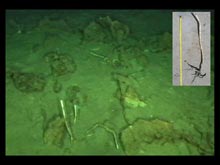
Figure 3. A picture of authigenic carbonate ridges sticking up from the mud near an underwater valley known as Green Canyon, 1,450 ft below the surface. Notice the tube worms in the lower left and upper center portions of the photo, and in the inset image. These animals consume food produced by bacteria that live in their tissues. Rather than using sunglight to make the worms’ food, the bacteria use substances dissolved in groundwater that seeps out around the ridges. Click image for larger view.
A sea-floor rock factory
At another location near a submerged valley called Green Canyon, other mysterious rocks are present almost 1,750 feet beneath the waves. They are lighter and softer than basalt, and contain holes made by boring sponges, clams, and worms that are not present in the basalt because it is too hard. These are young rocks that jut out of the mud—some are still being formed. These are also chemical rocks, not magma-formed rocks. The rocks are a special kind of limestone known as authigenic carbonate. They form in place when dissolved minerals crystallize out of groundwater as it seeps out of the sea floor around salt domes, especially along fault cracks. One easy way to tell whether these rocks are still forming is to look for evidence of living bacteria and associated animals (Fig. 3) that use fluids from the same seeps to make food, a process known as chemosynthesis.
I am a rock, I am an island
Whether basalt or authigenic carbonate, rocks are very important to deep-sea animals such as corals and sponges. Unlike the land plants that these branching organisms resemble, they do not need roots to supply them with water and nutrients. These come directly from the sea. They do, however, need to anchor themselves to hard substrates; otherwise, currents would sweep them away. Because of this, anything hard on the usually mud-covered floor of the deep ocean quickly becomes an island covered with abundant animal life.
Stories change over time. In some versions of Little Red Riding Hood, Grandma gets eaten by the Big Bad Wolf, and in other versions she gets locked in the closet. The stories of the rocks from under the sea will change as we learn more about them. What stories can the rocks in your yard tell? Find a rock, and then find a geologist to tell you its story. Better yet, become a geologist yourself, and tell your own stories.






















